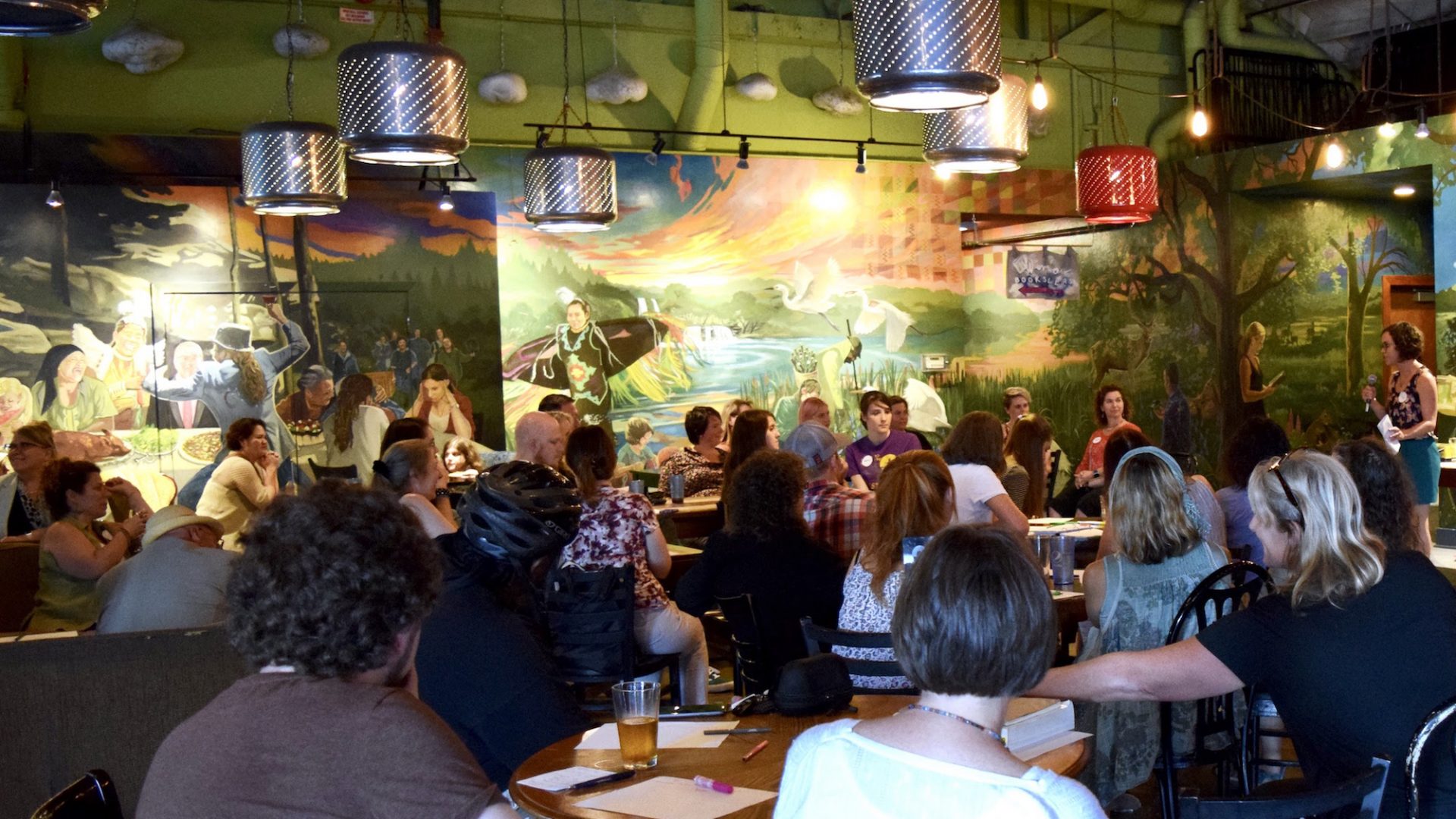What to do with what the news and social media do to us?

Many people check their phones in the morning before their first sip of coffee or tea. Our first moments of wakefulness are most often filled with information about other people’s lives, whether through social media or news stories about global warming, war, injustice and loss. Our outrage is necessary and has its place.
What happens to a body’s nervous systems when we start our days like this? Clients report feeling triggered, anxious and uncertain about how to settle themselves. Half asleep in their jammies, they land in their day feeling unsafe and under siege.
Picture two primary neurological response systems in the body. The crimson one (Sympathetic Nervous System) stimulates alarm and reactivity. The blue (Parasympathetic Nervous System) is oriented to higher thinking and intentional action. These neurological systems wrap around each other and in and out of our major organs. They alternate being in charge of the body’s responsiveness infrastructure, like the brakes and accelerator.
The sympathetic nervous system (SNS) kicks in when we do not feel safe.
When we hear bad news or feel fearful, we physically clamp down in our stomachs, butts or jaw, which results in the sympathetic nervous system yanking on a neurological cord that runs up the spine like a fire-bell. This activates a sprinkler system release of cortisol and adrenalin throughout the body. The flash of prickly sensations that make us feel hot or agitated is an indication that the SNS is activated. These chemicals are useful when we need to get safe fast and deal with pain. Most common SNS responses are Fight, Flight or Freeze, often in some combination of all three. This explains why when disappointed or outraged, people tend to hide in private, feel immobilized or want to take down their opponent any way that they can. We have likely been responding to conflict in a similar fashion throughout our life.

Alert, anxious, triggered and restless are words often used to describe the feeling of having one’s sympathetic nervous system activated. It happens all the time, in big and small ways. We might dip into SNS temporarily when we have a problem, feel like we have done someone wrong or are uncertain about a next step.
It is possible to live in a near constant state of heightened SNS. Consistent exposure to unsettling images or words can magnify this. It is exhausting to feel your sympathetic nervous system gunning insistently. People who are stuck in their SNS response can feel out of control and agitated, like they are running their nerves ragged. It can be challenging to know how to self soothe and one might be cranky or defensive with others. Though we might think that caffeine, sugar, alcohol or drugs could help soothe our system, the sense of agitation can be magnified by these daily life stimulants and depressants.
Useful note: When SNS is activated we have significantly less higher brain function. It is difficult to negotiate thoughtful problem solving. The fear or anger arousal track runs like a Harley Davidson revving in our brains drowning out any rational thoughts. News reports or indignant viewpoints on social media can arouse the SNS, giving us the message that in order to feel safer, we would be wise to steer away from or fight with, people or issues that are differently oriented from our own.
SNS language exposes itself through judgment and critical language. “What idiots….. morons….. sociopaths”.
This voice is self-righteous and defensive. We can re-trigger and reinforce our SNS again and again when we repeatedly consume information that blames others while reflecting our opinions back to ourselves.
We also have access to our rest and digest neurological response system that can be activated with intentionality.
The Parasympathetic Nervous System (PSNS) facilitates introspection and compassionate thinking when dealing with challenges and difficult decision-making. Monks, high performing artists and sports players train with discipline so that they can live more fully in their parasympathetic nervous system. Though we all have access to PSNS, for some it is similarly muted by activities that numb presence of mind. Drugs, alcohol, television or video games are common culprits.
When the PSNS/parasympathetic nervous system is activated, thinking becomes oriented to most effective problem solving. Ways to bring the PSNS on board include: changing body temperature, stretching limbs, deep breathing, swimming, running, meditation, muscle relaxation, nature and expressions of gratitude or optimism. From a PSNS perspective, it becomes possible to see the bigger story and to strategize choices with clarity.
Which is all very well except that we live in a world where we check our phones multiple times a day and bad news unfolds ceaselessly and we tend to want to do something to make a difference, to make it better.
Into the purple
Consider a third path. The purple path: 2/3 blue PSNS 1/3 red SNS.

It no longer serves for us to be frozen, fighting or quietly grounded on our yoga mats. We need to become activated. Between urgency and rest and digest is courageous action. This is where we bring alert and activated in step with calm and grounded. Moving from ungrounded urgency to alert and thoughtful attentiveness.
5 steps to walk the purple path: Awake and Intentional
Retraining your neurological system takes time and tons of practice, like learning to play the piano or a new sport.
Step one: Get Present
Track your thinking. When we are not present we are usually stuck in one of the six following categories of thinking: Future, Past, Self, Others, Like or Dislike. Become familiar with the particular mind cycles of non-present thinking that you habitually inhabit.
To do: Now
Take an expansive breath. Gently bring your self back to your self by noticing your body. Feel your feet in your socks in your shoes, feel where air is touching your bare skin, feel where you are holding tension in your body. Feel your wakefulness. Try to hold onto it without shifting to alarm. Ground it out by looking around and listening. Look at colors and shapes. Hear the sounds around you. Inhabit the moment.
Step two: Reduce triggers
Self soothe. Reduce access to agitating sources. Give yourself permission to turn off your device or limit the amount of time you give to contentious material. Grow familiar with the ways in which you tend to keep yourself triggered/in SNS. Try to notice when you are triggered and actively calm yourself. Be mindful of your choices first thing in the morning and last thing at night. Is there a softer way that you might like to start and end your day? Think about your sense of safety. What can you do to help yourself feel safer where you are, in the moment? Lean on safe others to decrease isolation and optimize soothing.
To do: Replenish
Return to activities that have fed or restored you in the past. Remember that in order to be most useful, it is important to be strong, rested and restored. Support yourself in this way so that you can be high performing in your efforts.
Step three: Find what is yours to do
Each of us has different skills, strengths, capacities that come easily and joyfully to us. Get clear on what you like to do, what you want to do. Research and network to get clear on where you want to use your precious time and energy so that it will be most effectively incorporated.
To do: Do what you love
When you play to your strengths, your energy will become self- sustaining, particularly if you are able to orbit around people you want to connect with.
Step Four: Walk your talk
Clarify your priorities and attend to them. Take no action until you know what the next right action needs to be. Give yourself time and space to get clear. Be certain that you are saying what needs to be said, doing what needs to be done and honor your best intentions even when you feel shy or uncertain. If what you are saying, or doing, is true to your integrity, tolerate the difference of opinion with others without causing yourself further distress or overreaction.
To do: Get clear
Stay in integrity with yourself. You have a right to your truth. Speak it!
Step five: Inhabit your courage
Walk the line between SNS and PSNS. Invite wakefulness without alarm or resistance and calm without checking out. Be on the lookout for opportunities to take action. When you see one, do the best you can with a compassionate heart.
To do: Be willing to participate
Risk being seen as a well-intentioned learner who is still finding your way. You don’t need to know it all.
Intentionality is everything.

Lola Broomberg, LPC, believes that in every person there is an impulse towards personal fulfillment which has often been hidden for its own security. Lola strives to understand what excites people, how they feel misunderstood, and how she can support them through her practice of warmhearted self-awareness. Visit LolaBroomberg.com.


